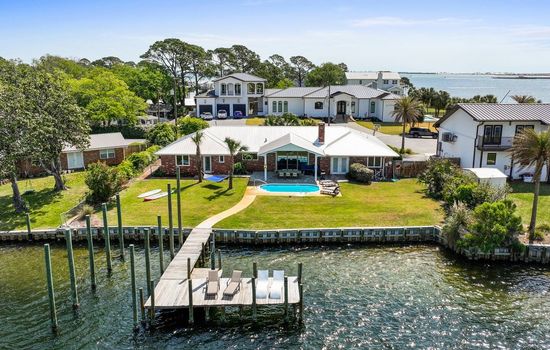The Visitor Center at Point Washington Wildlife Management Area offers insights into the local ecosystem and recreational opportunities. It is open daily from 8 AM to 5 PM, providing visitors with resources and information to enhance their experience in the natural surroundings.
There are no entrance fees for accessing the area, and parking is free at designated spots.
From Destin, take Highway 98 east for approximately 20 miles, then turn south on County Road 395. Follow the scenic route for about 10 minutes, where you’ll encounter a tranquil haven of nature, perfect for outdoor enthusiasts.
Accessibility & permits
Emergency
- Cell service availability:Full
Information not accurate?
Help us improve by making a suggestion.
Point Washington Wildlife Management Area, an enchanting expanse of Florida’s natural beauty, invites discerning travelers to immerse themselves in its serene landscapes. Spanning over 15,000 acres, this hidden gem showcases a diverse ecosystem, where lush pine forests meet tranquil wetlands. Visitors can explore a network of trails that wind through the area, offering glimpses of the rich wildlife that calls this sanctuary home.
As you traverse the winding paths, the sounds of nature envelop you, from the rustle of leaves to the calls of native birds. The area is a haven for birdwatchers, with species such as the elusive red-cockaded woodpecker and vibrant painted bunting gracing the skies. For those seeking adventure, the park provides ample opportunities for hiking, biking, and wildlife observation, making it an ideal retreat for outdoor enthusiasts.
Point Washington Wildlife Management Area also serves as a reminder of the importance of conservation. Its pristine environment not only protects local flora and fauna but also offers a peaceful escape from the hustle and bustle of modern life. This tranquil oasis promises an unforgettable experience, perfect for those looking to reconnect with nature in a luxurious setting.
Top 3 Facts about Point Washington Wildlife Management Area
This area is home to rare species like the gopher tortoise and the red-cockaded woodpecker, while unusual sightings include the occasional manatee in freshwater, and during migration seasons, diverse bird species flock in astonishing numbers, showcasing the region’s rich biodiversity and ecological significance.
In this unique region, the convergence of coastal and inland weather patterns creates rare microclimates, leading to unexpected phenomena such as localized storms that can produce heavy rainfall in one area while leaving neighboring zones completely dry, showcasing the intricate dynamics of weather systems.
Known for its unique trail names like “Bizarre Loop” and the unusual rule prohibiting motorized vehicles, this area also boasts records in outdoor sports such as the longest paddleboarding distance achieved in a single outing, attracting adventurers seeking both challenge and novelty.
Family programs
- Junior Ranger
- Ranger-led Tours
- Scavenger Hunts
- Night Sky & Astronomy
- Family Camping & Overnight
- Virtual Junior Activities
- Arts & Crafts
Travel Tips
Plan Ahead
Planning ahead is essential for a seamless visit to this stunning wildlife haven. Check weather conditions, pack plenty of water, and wear sturdy footwear to navigate the diverse trails comfortably. Arrive early to enjoy the tranquility before the crowds, and consider bringing binoculars to fully appreciate the rich birdlife and scenic vistas. A well-thought-out plan ensures an unforgettable experience in nature.
Pack Appropriately
When packing for your visit, include a pair of water shoes; the area’s diverse ecosystems feature both sandy trails and wetlands. These shoes will protect your feet while allowing you to explore the unique habitats and hidden trails without worrying about slippery surfaces or sharp objects, enhancing your adventure in this beautiful Florida landscape.
Respect Wildlife
Respecting wildlife in this stunning Florida haven is essential for both your safety and the animals’ well-being. Keep a respectful distance from all creatures, avoid feeding them, and stick to marked trails to minimize your impact on their habitats. Observing animals in their natural environment is best done quietly and patiently, ensuring a memorable and responsible experience.
Stay Informed
Stay informed before your visit by checking current weather conditions, temperatures, and any fire bans or notices. Make sure to share your plans with someone, including your destination and expected return time, and keep emergency contact information handy for a safe outing.
Seasons
Spring’s mild temperatures and vibrant flora make it an ideal season to explore the diverse trails and abundant wildlife of this coastal forest.
Summer’s warm temperatures and abundant sunshine make June, July, and August ideal for exploring the diverse ecosystems, hiking trails, and wildlife of this coastal Florida haven.
In fall, the area offers cooler temperatures and vibrant wildflower blooms, making September through November ideal for hiking, biking, and birdwatching amidst diverse habitats.
Experience the serene beauty of Florida’s coastal forests during winter months when mild temperatures and abundant wildlife make December through February ideal for hiking, birding, and off-road cycling adventures.
Information not accurate?
Help us improve by making a suggestion.
Where to stay
Frequently Asked Questions
Ready to dive into what Point Washington Wildlife Management Area has to offer? Let’s tackle some of the burning questions you might have as you plan your visit!
-
Point Washington Wildlife Management Area offers a variety of outdoor activities including hiking, birdwatching, and wildlife observation. With over 15 miles of trails, visitors can explore the natural beauty of the area, including wetlands and pine forests. Fishing is also popular in the nearby coastal waters, providing ample opportunities for anglers.
-
Pets are allowed in Point Washington Wildlife Management Area, but they must be kept on a leash at all times. It’s important to clean up after your pets to maintain the area’s natural beauty and ensure a pleasant experience for all visitors.
-
The best time to visit Point Washington Wildlife Management Area is during the cooler months, from late fall to early spring. This period offers comfortable temperatures for hiking and wildlife viewing, while summer can be hot and humid with increased insect activity.
-
There are no designated camping facilities within Point Washington Wildlife Management Area. However, nearby campgrounds and state parks provide options for visitors looking to camp in the vicinity.
-
Wildlife enthusiasts can expect to see a diverse range of species in Point Washington Wildlife Management Area. Common sightings include white-tailed deer, wild turkeys, and various bird species such as ospreys and herons. The area is also home to several reptiles and amphibians, making it a rich habitat for wildlife observation.



